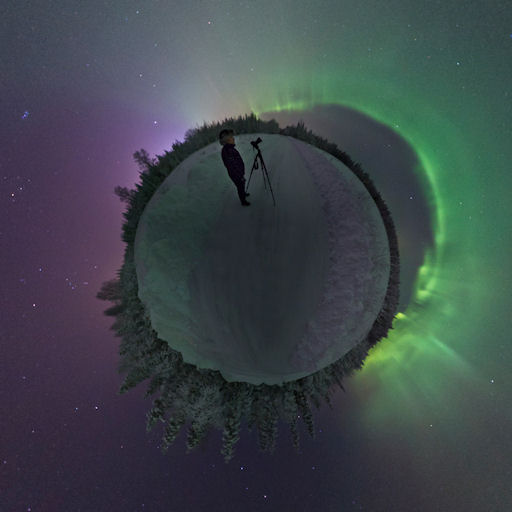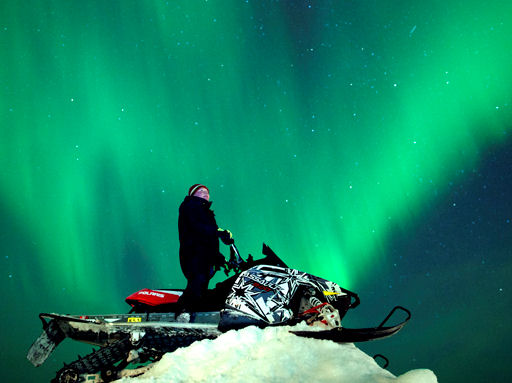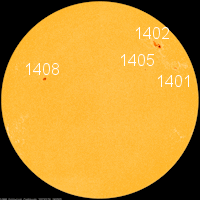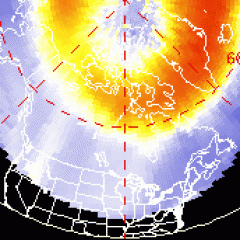SUBSIDING STORM: A geomagnetic storm caused by Monday's M9-class solar flare and Tuesday's CME impact is over. The aurora watch is cancelled for all but the highest latitudes around the Arctic Circle.
STORM RECAP: As expected, a CME hit Earth's magnetic field on Jan. 24th at approximately 1500 UT (10 am EST). The impact produced a G1-class geomagnetic storm and bright auroras around the Arctic Circle. As the storm crested, Göran Strand of Östersund, Sweden, took a panoramic photo and wrapped it 360-degrees to create this composition, which he calls Planet Aurora:
Even veteran aurora watchers were impressed. "This was one of the best Northern Lights displays that I've ever seen, and I mean ever in over 5000 hours on the ice," says Andy Keen of Inari, Finland. "It was, in short, truly spectacular and something that will live with me for a lifetime." In the Abisko National Park of Sweden, aurora tour guide Chad Blakely contributed a similar report: "Eight tourists and I were treated to one of the most wonderful displays I have ever seen. The auroras began as we were eating dinner and continued into the very early hours of the morning. Words can not describe the excitement we shared."
The storm subsided as it crossed the Atlantic and petered out almost completely by the time it reached North America. Only observers in Scandinavia, Iceland and Greenland witnessed the full display:
"We went out with snowmobiles to wait for the incoming storm," says photographer Antti Pietikäinen of Muonio in the Finnish Lapland. "The show started slowly, but after 15mins the landscape was green! This was the first time for Thomas (pictured above) to see the Northern Lights. He was very happy." Aurora alerts: text, voice.

![]()
Solar wind
speed: 593.9 km/sec
density: 3.4 protons/cm3
explanation | more data
Updated: Today at 1416 UT
![]()
X-ray Solar Flares
6-hr max: B8 0906 UT Jan25
24-hr: B9 0157 UT Jan25
explanation | more data
Updated: Today at: 1400 UT
![]()
![]()
![]()
Daily Sun: 25 Jan 12
![]()
![]()
Sunspot 1402 poses a threat for M-class solar flares. Credit: SDO/HMI
![]()
![]()
![]()
Sunspot number: 105
What is the sunspot number?
Updated 23 Jan 2012
Spotless Days
Current Stretch: 0 days
2012 total: 0 days (0%)
2011 total: 2 days (<1%)
2010 total: 51 days (14%)
2009 total: 260 days (71%)
Since 2004: 821 days
Typical Solar Min: 486 days
Updated 23 Jan 2012
The Radio Sun
10.7 cm flux: 137 sfu
explanation | more data
Updated 23 Jan 2012
![]()
![]()
![]()
Current Auroral Oval:
![]()
Switch to: Europe, USA, New Zealand, Antarctica
Credit: NOAA/POES
![]()
![]()
![]()
Planetary K-index
Now: Kp= 4 unsettled
24-hr max: Kp= 5 storm
explanation | more data
![]()
Interplanetary Mag. Field
Btotal: 6.0 nT
Bz: 4.4 nT south
explanation | more data
Updated: Today at 1416 UT
![]()
![]()
![]()
Coronal Holes: 24 Jan 12
![]()
![]()
Solar wind flowing from the indicated coronal hole should reach Earth on Jan. 27-28. Credit: SDO/AIA.






